The Optical Whitening Agents Market is estimated to be valued at USD 3.7 billion in 2025 and is projected to reach USD 5.7 billion by 2035, registering a compound annual growth rate (CAGR) of 4.5% over the forecast period.
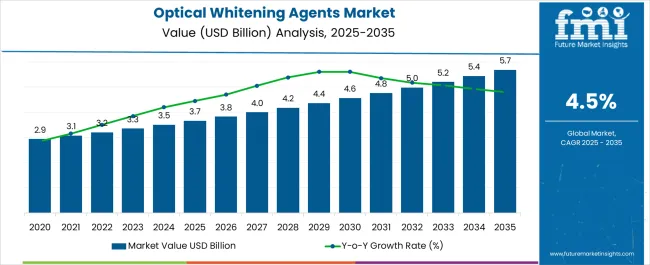
| Metric | Value |
|---|---|
| Optical Whitening Agents Market Estimated Value in (2025 E) | USD 3.7 billion |
| Optical Whitening Agents Market Forecast Value in (2035 F) | USD 5.7 billion |
| Forecast CAGR (2025 to 2035) | 4.5% |
The Optical Whitening Agents market is experiencing steady growth, driven by the rising demand for brighter and whiter appearances across textiles, paper, plastics, and detergent applications. Increasing consumer preference for visually appealing products and premium quality materials is fueling adoption of optical whitening agents in various industries. Technological advancements in chemical formulations and photostability are enhancing the performance and durability of these agents, making them more effective under different environmental conditions.
The market is further supported by growing investments in research and development aimed at improving optical brightness and reducing material degradation. Sustainability concerns and regulatory compliance requirements are encouraging manufacturers to develop safer and more environmentally friendly whitening agents, which is driving innovation.
The rising focus on quality control in textile and consumer goods industries is also contributing to higher adoption As end-use industries continue to prioritize enhanced aesthetics, product longevity, and compliance with environmental standards, the Optical Whitening Agents market is expected to witness sustained growth over the coming decade.
The optical whitening agents market is segmented by application, type, and geographic regions. By application, optical whitening agents market is divided into Textiles, Paper And Pulp, Detergent, Plastics, Fibers, Coatings And Inks, Cosmetics, Synthetics And Fabrics, Photo Processing Solutions, and Others. In terms of type, optical whitening agents market is classified into Stilbene, Coumarin, Pyroazoline, Triazoles, Benzoxazolines, Biphenyl Stilbenes, and Others. Regionally, the optical whitening agents industry is classified into North America, Latin America, Western Europe, Eastern Europe, Balkan & Baltic Countries, Russia & Belarus, Central Asia, East Asia, South Asia & Pacific, and the Middle East & Africa.
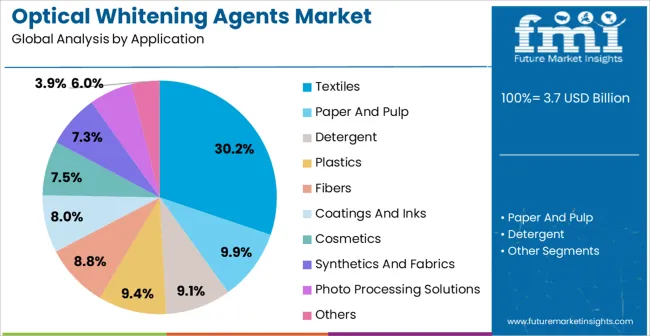
The textiles application segment is projected to hold 30.2% of the market revenue in 2025, establishing it as the leading application area. Growth in this segment is driven by the need to enhance the brightness, whiteness, and visual appeal of fabrics, including cotton, synthetic blends, and technical textiles. Optical whitening agents help maintain consistent color quality during washing, finishing, and processing, which is critical for high-value textile products.
The adoption of these agents is supported by advancements in chemical formulations that improve photostability, minimize fabric degradation, and increase efficiency under industrial dyeing and finishing processes. Rising demand from apparel, home textiles, and technical fabrics has reinforced their importance.
Manufacturers benefit from reduced chemical consumption, improved product consistency, and enhanced fabric aesthetics, which contribute to market preference As textile industries continue to expand globally and consumers demand higher-quality fabrics, the textiles application segment is expected to maintain its leadership position, supported by ongoing innovation in optical whitening agents.
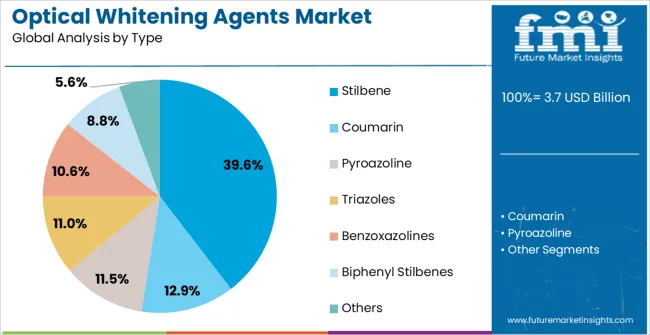
The stilbene type segment is anticipated to account for 39.6% of the market revenue in 2025, making it the leading type in the Optical Whitening Agents market. Its growth is driven by the superior performance characteristics of stilbene-based agents, including high optical brightness, excellent photostability, and compatibility with a wide range of substrates such as textiles, plastics, and paper.
Stilbene agents effectively absorb ultraviolet light and emit visible blue light, enhancing perceived whiteness without altering material properties. The segment’s popularity is also reinforced by ease of formulation, efficient application methods, and long-term stability, which reduce production costs and improve product quality.
Continuous improvements in chemical synthesis and environmental compliance are expanding their adoption in global markets As end-use industries demand higher performance, longer-lasting whiteness, and regulatory-compliant solutions, stilbene-based optical whitening agents are expected to maintain their leading position, supported by technological innovation and growing awareness of quality standards.
The optical whitening agents are also called as optical brightening agents or fluorescent whitening agents. The optical whitening agents are chemicals used to make the plastics, fibers, coatings, inks and detergents to look brighter. The basic working principle of optical whitening agents is that they absorb the ultraviolet light and re-emit it as visible light in the blue region of the spectrum.
The optical whitening agents are also being widely used in dyes to make the color appear more vibrant. The optical whitening agents are the specialty chemicals that belong to the category of synthetic organic coloring matter. The optical whitening agents are added to enhance the aesthetics and consumer appeal.
The optical whitening agents have replaced bluing, which was traditionally used to give the same affect to clothes. The optical whitening agents are mostly the stilbene-based chemicals. The optical lightening agents have many advantages such as light fastness, readily soluble in organic solvents, high chemical stability and improved resistance to heat amongst others.
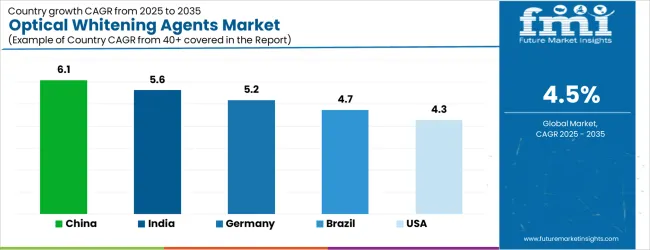
| Country | CAGR |
|---|---|
| China | 6.1% |
| India | 5.6% |
| Germany | 5.2% |
| Brazil | 4.7% |
| USA | 4.3% |
| UK | 3.8% |
| Japan | 3.4% |
The Optical Whitening Agents Market is expected to register a CAGR of 4.5% during the forecast period, exhibiting varied country level momentum. China leads with the highest CAGR of 6.1%, followed by India at 5.6%. Developed markets such as Germany, France, and the UK continue to expand steadily, while the USA is likely to grow at consistent rates. Japan posts the lowest CAGR at 3.4%, yet still underscores a broadly positive trajectory for the global Optical Whitening Agents Market. In 2024, Germany held a dominant revenue in the Western Europe market and is expected to grow with a CAGR of 5.2%. The USA Optical Whitening Agents Market is estimated to be valued at USD 1.3 billion in 2025 and is anticipated to reach a valuation of USD 1.3 billion by 2035. Sales are projected to rise at a CAGR of 0.0% over the forecast period between 2025 and 2035. While Japan and South Korea markets are estimated to be valued at USD 193.6 million and USD 110.7 million respectively in 2025.
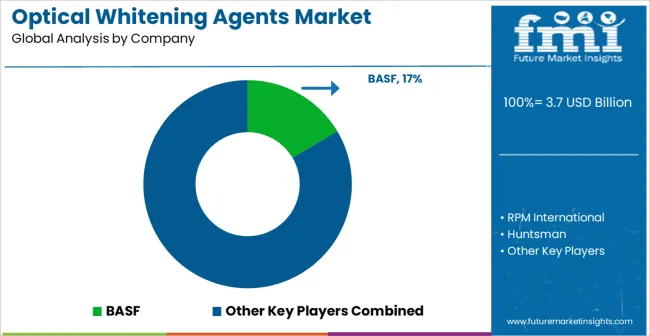
| Item | Value |
|---|---|
| Quantitative Units | USD 3.7 Billion |
| Application | Textiles, Paper And Pulp, Detergent, Plastics, Fibers, Coatings And Inks, Cosmetics, Synthetics And Fabrics, Photo Processing Solutions, and Others |
| Type | Stilbene, Coumarin, Pyroazoline, Triazoles, Benzoxazolines, Biphenyl Stilbenes, and Others |
| Regions Covered | North America, Europe, Asia-Pacific, Latin America, Middle East & Africa |
| Country Covered | United States, Canada, Germany, France, United Kingdom, China, Japan, India, Brazil, South Africa |
| Key Companies Profiled | BASF, RPM International, Huntsman, Clariant, Keystone Aniline, Brilliant Group, Aron Universal, 3V, TEH Fong Min International, and Archroma |
The global optical whitening agents market is estimated to be valued at USD 3.7 billion in 2025.
The market size for the optical whitening agents market is projected to reach USD 5.7 billion by 2035.
The optical whitening agents market is expected to grow at a 4.5% CAGR between 2025 and 2035.
The key product types in optical whitening agents market are textiles, paper and pulp, detergent, plastics, fibers, coatings and inks, cosmetics, synthetics and fabrics, photo processing solutions and others.
In terms of type, stilbene segment to command 39.6% share in the optical whitening agents market in 2025.






Our Research Products

The "Full Research Suite" delivers actionable market intel, deep dives on markets or technologies, so clients act faster, cut risk, and unlock growth.

The Leaderboard benchmarks and ranks top vendors, classifying them as Established Leaders, Leading Challengers, or Disruptors & Challengers.

Locates where complements amplify value and substitutes erode it, forecasting net impact by horizon

We deliver granular, decision-grade intel: market sizing, 5-year forecasts, pricing, adoption, usage, revenue, and operational KPIs—plus competitor tracking, regulation, and value chains—across 60 countries broadly.

Spot the shifts before they hit your P&L. We track inflection points, adoption curves, pricing moves, and ecosystem plays to show where demand is heading, why it is changing, and what to do next across high-growth markets and disruptive tech

Real-time reads of user behavior. We track shifting priorities, perceptions of today’s and next-gen services, and provider experience, then pace how fast tech moves from trial to adoption, blending buyer, consumer, and channel inputs with social signals (#WhySwitch, #UX).

Partner with our analyst team to build a custom report designed around your business priorities. From analysing market trends to assessing competitors or crafting bespoke datasets, we tailor insights to your needs.
Supplier Intelligence
Discovery & Profiling
Capacity & Footprint
Performance & Risk
Compliance & Governance
Commercial Readiness
Who Supplies Whom
Scorecards & Shortlists
Playbooks & Docs
Category Intelligence
Definition & Scope
Demand & Use Cases
Cost Drivers
Market Structure
Supply Chain Map
Trade & Policy
Operating Norms
Deliverables
Buyer Intelligence
Account Basics
Spend & Scope
Procurement Model
Vendor Requirements
Terms & Policies
Entry Strategy
Pain Points & Triggers
Outputs
Pricing Analysis
Benchmarks
Trends
Should-Cost
Indexation
Landed Cost
Commercial Terms
Deliverables
Brand Analysis
Positioning & Value Prop
Share & Presence
Customer Evidence
Go-to-Market
Digital & Reputation
Compliance & Trust
KPIs & Gaps
Outputs
Full Research Suite comprises of:
Market outlook & trends analysis
Interviews & case studies
Strategic recommendations
Vendor profiles & capabilities analysis
5-year forecasts
8 regions and 60+ country-level data splits
Market segment data splits
12 months of continuous data updates
DELIVERED AS:
PDF EXCEL ONLINE
Optical Fiber Cold Joint Market Size and Share Forecast Outlook 2025 to 2035
Optical Spectrum Analyzer Market Size and Share Forecast Outlook 2025 to 2035
Optical Extinction Analyzer Market Size and Share Forecast Outlook 2025 to 2035
Optical Character Recognition Market Forecast and Outlook 2025 to 2035
Optical Satellite Market Size and Share Forecast Outlook 2025 to 2035
Optical Imaging Market Size and Share Forecast Outlook 2025 to 2035
Optical Fingerprint Collector Market Size and Share Forecast Outlook 2025 to 2035
Optical Lens Materials Market Size and Share Forecast Outlook 2025 to 2035
Optical Microscope Market Size and Share Forecast Outlook 2025 to 2035
Optical Component Tester Market Size and Share Forecast Outlook 2025 to 2035
Optical EMI Shielding Adapters Market Size and Share Forecast Outlook 2025 to 2035
Optical Connector Polishing Films Market Size and Share Forecast Outlook 2025 to 2035
Optical Transmitter Market Size and Share Forecast Outlook 2025 to 2035
Optical Telephoto Lens Market Size and Share Forecast Outlook 2025 to 2035
Optical Lattice Clock Market Size and Share Forecast Outlook 2025 to 2035
Optical Grade Lithium Tantalate Wafers Market Size and Share Forecast Outlook 2025 to 2035
Optical Grade LiTaO3 Crystal Substrate Market Size and Share Forecast Outlook 2025 to 2035
Optical Brighteners Market Size and Share Forecast Outlook 2025 to 2035
Whitening Gold Peptide Complex Market Size and Share Forecast Outlook 2025 to 2035
Optical Liquid Level Sensor Market Size and Share Forecast Outlook 2025 to 2035

Thank you!
You will receive an email from our Business Development Manager. Please be sure to check your SPAM/JUNK folder too.
Chat With
MaRIA